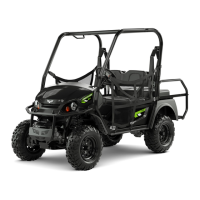20
OPERATION
Seat Belt Operation
Seat belts must be worn by all occupants whenever vehicle is in motion.
Make sure seat belts are free from twists and latch securely.
Position shoulder belt across the top of the shoulder; do not place shoulder belt under the arm.
Keep belts snug and positioned low on hips. Loose fitting belts significantly reduce protection.
The vehicle is equipped with seat belts for the number of occupants it is designed to carry; do not exceed the recom-
mended number of occupants for the vehicle.
Seat belts are designed for one occupant per belt. Do not attempt to secure more than one person in a seat belt.
Seat belts must be worn at all times by all occupants when vehicle is in motion.
To keep seat belts in proper working condition, do the following:
• Inspect the seat belt webbing and hardware periodically. Check for cuts, frays or loose parts. Replace components if excessive wear or damage is
noticed.
• Keep seat belts clean and dry. To clean, use mild soap and warm water. Do not use bleach, dye or abrasive cleaners as this will weaken the belt webbing
material.
• Do not insert any foreign objects into the retractor mechanism.
• Periodically check for smooth operation and replace if the mechanism is not operating properly.
To properly secure the seat belts:
1. Pull the metal tab on the seat belt across the body toward the appropriate buckle located near the center of the seat.
2. Insert tab into buckle. (A click will be heard when the tab is securely latched).
3. Position the lap belt as low as possible on the hips, not at the waist.
4. Adjust to ensure a snug fit by pulling the shoulder portion upward.
The retractor will lock the belt during sudden stops. It may also lock if occupant leans forward quickly. Slow, easy motions allow the belt to travel freely.
To release the safety belt, press the buckle release button and allow the belt to retract. If the belt does not retract, check for a twist in the belt.
Common Sense Operation
Never transport loaded firearms on or in vehicle.
Check that firearms are unloaded with the safety engaged and are properly secured with muzzle pointing in a safe direc-
tion before operating vehicle. Be aware of other firearms in proximity to operator and passengers.
This vehicle is not a toy. If not operated properly and responsibly, it can cause severe injury or death to the operator, passengers or bystanders. All operators
should possess a valid driver’s license. Children should not be permitted to operate the vehicle. Children may not have the skill, judgment or strength to oper-
ate this or similar vehicles.
Alcohol, drugs and many over the counter medications reduce the ability of the driver to operate the vehicle safely. Always review side effects of any medica-
tion with a doctor or pharmacist before operating vehicle.
Protective clothing and an approved motorcycle helmet are recommended for operator and passengers when operating vehicle in rough or densely wooded
terrain.
When driving at full speed on a dirt road, loose surfaces or wet grass, vehicle stopping distance will increase. If the vehicle is fully loaded, it requires longer to
stop than with no load. When operating vehicle in wet weather conditions, remember that the brakes may need to be lightly applied in order to provide enough
friction to dry the brake unit. If wet, the brakes lose much of their effect.
Slow down when on unfamiliar terrain. Slow down when cresting a hill in an area that is not familiar.
Some hills are too steep to climb. If attempting to climb a hill that is too steep or if unable to achieve adequate traction, do not attempt to turn around on the
hill. Slowly back straight down the hill using the brake pedal to control speed.
Environmental Concerns
As a responsible user, practice respect for all wildlife and their habitat. Respect private property and comply with all
local laws and regulations governing the use of light duty utility vehicles. To prevent severe injury or death while driv-
ing, be aware of environmental hazards such as steep slopes, overhanging limbs, etc.
Starting and Driving
• Make sure that the accelerator pedal is NOT pressed (no pressure on it).
• Place key in switch and turn to desired position.
• Press the accelerator pedal to move the vehicle.
Make sure the key switch is in the OFF position and the key is removed from the switch before exiting the vehicle.
This vehicle is to be operated by licensed drivers only.
Do not attempt to operate the vehicle while under the influence of drugs or alcohol.
Never turn the key switch to OFF while the vehicle is in motion; doing so can cause loss of control and lead to serious injury or death.
On a downhill slope, it is possible for the vehicle to achieve speeds greater than if it were operating on flat terrain. Limit downhill speed to 5 mph (8 kph) with
use of the brake pedal.
Caution must also be used on an uphill slope and speed should be limited to no more than 5 mph (8 kph).
If allowed to travel too fast on an uphill or downhill slope, loss of control may occur, possibly causing serious injury or death.

